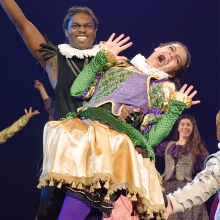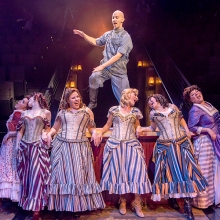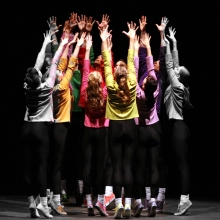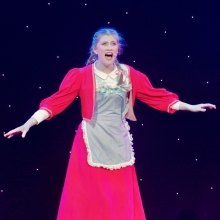Filichia Features: Welcome to the Junior Theater Festival, Part 2
Filichia Features: Welcome to the Junior Theater Festival, Part 2
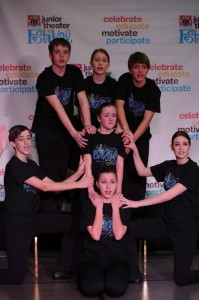 When we last left the 63 casts of students participating in this year’s Junior Theater Festival, they were off to one of seven rooms. In each, they’d perform what could be called junior versions of Broadway Jr. musicals: up to 15 minutes worth of material that would show them at their best.
When we last left the 63 casts of students participating in this year’s Junior Theater Festival, they were off to one of seven rooms. In each, they’d perform what could be called junior versions of Broadway Jr. musicals: up to 15 minutes worth of material that would show them at their best.
Here in the Jafar Room, each of the two side walls is flanked with an enormous painted drop that celebrates a musical. How nice that the recent High School Musical peacefully co-exists with the vintage Irving Berlin’s White Christmas.
Behind the kids is a banner that urges everyone to “Celebrate, Educate. Motivate and Participate.” That’s what Queen’s Grant Community School from Mint Hill, North Carolina will do right now with Alice in Wonderland, Jr.
Those who prefer unamplified sound will find it here. While the CD player offers a pre-recorded instrumental track, a microphone isn’t clipped onto any kid. But the students’ joy usually has their voices carry past the rows upon rows of seats.
It’s oft been said that the number one terror that a person faces is getting up and speaking before an audience. These kids show that they shed that fear long ago. They’ve already learned what Alice in Wonderland, Jr. tells them: “If you don’t explore, you’ll never discover.”
While performing, the students smile broadly. To be sure, drama teachers always tell kids to do that, on the assumption that the audience will have a better time if they do. These students, however, suggest that they smile because they’re genuinely in love with what they’re doing.
The three adjudicators -- Michael Bobbitt of Adventure Theatre in Washington, D.C., Kelby McIntyre Martinez, a director of a Utah arts program, and Jeff Calhoun, the director of the upcoming Broadway musical Newsies -- are all mighty impressed – and say so. “Musical theater people are storytellers, and you told the story quite well,” says McIntyre Martinez. The kids respond with smiles that show both pride and modesty.
But as the adjudication turns serious, so do the kids’ faces. “Yes,” they seem to be saying, “tell us what can make us better.” Bobbitt mentions elocution. “Work on your ‘m’s’ and you ‘b’s.’ Has your director given you that note?” Moans one guilty-as-charged student, “Many times.”
“You weren’t scared enough of the Queen,” says McIntyre Martinez. “Try it again!” The kids’ faces show eagerness to get it right. “Good! Good!” she says, and means it, for the best possible reason: they did.
BRAVO Academy of Oak Park, Illinois performs Schoolhouse Rock, Jr. It reminds us of “The Great American Melting Pot” in which it’s “great to be an American -- and something else as well.” As for people of different cultures, “you can learn from them -- and they can learn from you.”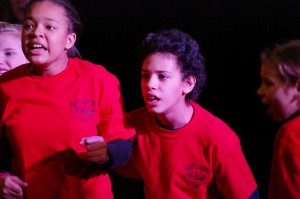
No fewer than 42 kids participate, and all are so winning while singing and dancing that McIntyre Martinez is moved enough to start rhythmically clapping along. The first of her loud claps is enough to get many in attendance to enthusiastically join her.
Afterward, Calhoun shows his awe. “This cast,” he proclaims, “is a family.” He also lauds them because “you didn’t only show who your characters were when you were center stage; even when you were in the wings, you established who they were.”
While some may think that musical theater simply means song and dance, South Arbor Academy from Ypsilanti, Michigan reminds us with Disney’s Beauty and the Beast, Jr. that acting is of paramount importance, too. A girl who’s portraying one of Gaston’s greatest admirers purposely and slowly twirls the ends of her hair as a way of suggesting that she’s utterly captivated by him and doesn’t know what to do with her hands. As for Belle and the Prince, they appear to be so in love that they seem to be a real-life couple.
They aren’t, as we learn during the adjudication. Bobbitt remarks, “It’s hard for an actor to keep actually listening when he knows what the other person is going to say in advance. At any age, that’s an accomplishment, but it’s especially great that you can do it at your age.”
Calhoun praises them for not just getting the juice out of “Belle” and “Be Our Guest,” but also the title song. “It’s much harder to do a ballad than an up-tempo – especially when you’re singing to a pre-recorded track with no conductor. You’re basically singing a capella,” he adds, before slowly shaking his head when he remembers how hard that is.
But Calhoun thinks that the kids’ slow-motion sequence could have been better. “Act as if you’re moving through peanut butter,” he suggests. The kids get the image in their heads and when they try it again, they’re moving much more slowly. But Calhoun wants more. “Not smooth peanut butter,” he instructs. “Thick, chunky peanut butter.” Now the students seem to be genuinely fighting the air to move an inch. Their efforts make Calhoun come out with a big “Good!” and an even bigger smile.
Bobbitt has some advice for the kids who started the tale with narration. “When you narrate, don’t just say the words. Take on the emotions of the character you’re describing.”
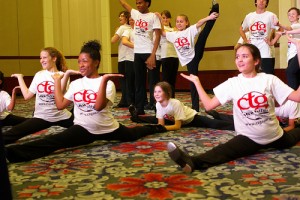 And during the next show – River Trail Middle School’s Once on This Island, Jr. – one of the narrators, when telling of the uppity Beauxhomme family, sounds extraordinarily hoity-toity and flips her hair with insouciance. Had this been the haughty attitude that she’d been playing back home in Johns Creek, Georgia? Or had she just learned from Bobbitt’s advice? Only she knows for sure, but however it happened, she did the job.
And during the next show – River Trail Middle School’s Once on This Island, Jr. – one of the narrators, when telling of the uppity Beauxhomme family, sounds extraordinarily hoity-toity and flips her hair with insouciance. Had this been the haughty attitude that she’d been playing back home in Johns Creek, Georgia? Or had she just learned from Bobbitt’s advice? Only she knows for sure, but however it happened, she did the job.
The first four casts have been large, but Central Drama Players from Mayfield, Kentucky has only eight students doing Annie, Jr. In the festival’s souvenir program, the picture of the actual production shows that 28 had been in the cast. Perhaps the school simply didn’t have the money to send everyone.
But the octet doesn’t seem remotely intimidated to be following large-cast shows. The lass portraying Annie gets genuine emotion out of “Maybe,” and she and the boy playing Daddy Warbucks harmonize beautifully on “I Don’t Need Anything but You.” Other students double and triple with ease. After they finish and take their curtain calls, a spectator could be pardoned for not remembering that only eight had been involved. The kids had done such an exemplary job filling the stage that they made themselves seem more than the sum of their parts.
Meanwhile, in the Flat Stanley Room, Mountain Brook Junior High School from Birmingham, Alabama has just finished its High School Musical, Jr. Adjudicator Kenny Shepard applauds a teacher who used a student choreographer. When he tells the kid, “If you want to choreograph, go to your local grammar school and volunteer,” the student’s mouth opens in awe. She’d never thought of that. The way her eyes sparkle says that she can’t wait to get back home and start beating on grammar school doors.
Now the Jeter Backyard Theater from Pittsburgh will perform its slice of Into the Woods, Jr. The person in charge of the CD player has a hard time making it start. Suddenly the music is playing, and the Narrator must jump in. He does, but other kids can’t make the adjustment. Pittsburgh, we have a problem.
All three adjudicators decide to stop the show and demand that it start again. There are no cries of outrage from the audience; kids, teachers and parents apparently think that this is lofty and fair. At the Junior Theater Festival, you do get a second chance to make a first impression.
Who says that Sondheim is too difficult for students? If you don’t let kids know that something’s impossible, they just go out and do it. That includes a young man who wanted to play the Witch. As soon as he begins his rap about “rooting through my rutabaga” and raiding my arugula,” one sees why his teacher just had to cast him.
As for the famous scene in which the Witch is transformed into a great beauty, that’s easily accomplished. The collected students part like the Red Sea and a pretty girl is revealed and ready to take his place.
Sondheim meant such lines as “children will listen” and “children will see and learn” as a warning to parents. These kids remind us that listening, seeing and learning can also be extraordinarily beneficial.
The Academy of Creative Excellence in Lexington, Kentucky now brings the performance part of the festival to a close with their Seussical, Jr. As soon as the kids finish the sequence with “Green Eggs and Ham,” the crowd goes wild. One can feel that this is a favorite song of many, and they were hoping all along that the academy would include it in its presentation.
Their exuberance also suggests a more important value. While every iota of jealousy may not be eradicated from each kid’s mind and soul, there are few green eyes at “Green Eggs and Ham.” The kids are busy being more impressed than envious at what their peers have achieved. They know how hard mastering a line, song or dance is. They can do nothing but “whoo” in approval.
Lunchtime. The kids have done their shows, but as they file out, some are heard still singing snatches of the songs. They can’t get the melodies out of their head, and they don’t want to.
For decades, there has been an after-school club called Future Teachers of America. The Junior Theater Festival may well offer multiple clubs in one: Future Stars of America, Future Working Actors of America, Future Lawyers of America, and most of all, Future Successes of America.
 You may e-mail Peter at pfilichia@aol.com. Check out his weekly column each Tuesday at www.masterworksbroadway.com and each . and each Friday at www.kritzerland.com. His newest book, Broadway Musical MVPs, 1960-2010: The Most Valuable Players of the Past 50 Seasons, is now available through Applause Books and at www.amazon.com.
You may e-mail Peter at pfilichia@aol.com. Check out his weekly column each Tuesday at www.masterworksbroadway.com and each . and each Friday at www.kritzerland.com. His newest book, Broadway Musical MVPs, 1960-2010: The Most Valuable Players of the Past 50 Seasons, is now available through Applause Books and at www.amazon.com.
Share
Callboard
-
Shake and shimmy it with the #Hairspray20Challenge! Join MTI and Broadway Media in celebrating 20 years of #Hairspray. Duet this here or find us on TikTok! Special thanks to @broadwaymedia and @jammyprod. Choreography Guides are a licensor official resource that provides step-by-step instruction from Broadway and professional choreographers for your productions! Visit @broadwaymedia to learn more. #mtishows #youcantstopthebeat #hairspraymusical #goodmorningbaltimore
View on Instagram





















